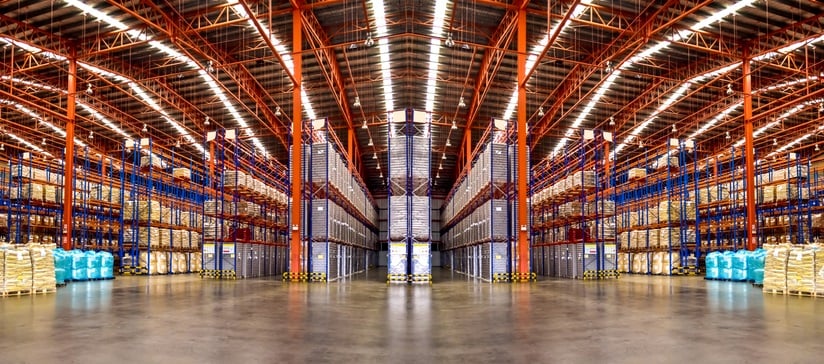Micro-Fulfillment Centers: Benefits, Typical Cost and Payback Period

Installing a micro-fulfillment center (MFC) is a business decision, which involves an upfront investment and benefits over time. According to Marc Wulfraat, President and Founder of MWPVL International, a 12,000 sf MFC has a typical cost of $5 million, but this can vary depending on site conditions. Laura Scott, COO of Takeoff Technologies Inc., provided a comparable figure of $3 million for a 10,000 sf MFC.
An MFC reduces the order picking time and cost, allowing faster sales and higher profits. According to the global supply chain consulting firm Chainalytics, the typical cost per order is $10-$15 with manual picking, but an MFC reduces it to only $3-$5. Thanks to automation, orders can also be processed faster: some micro-fulfillment systems have a throughput of over 600 units per hour (UPH), while manual fulfillment is normally limited below 100 UPH.
Are you planning an urban fulfillment center? Get a professional MEP design.
Same-day delivery was once a premium service, but is now becoming a requirement for online retailers. According to Honeywell Intelligrated, same-day delivery is now expected by 56% of customers between ages 18 and 34.
MFC Advantages: Faster Picking and Lower Cost

MWPVL International published a case study that compares order fulfillment costs for a bottle of ketchup, using five different fulfillment strategies. For retailers, the lowest order processing cost is achieved when customers purchase products normally, since the order picking and last-mile delivery steps are eliminated.
|
Order Fulfillment Method |
Retailer Cost |
Paid Labor Time |
|
In-store purchase (baseline) |
$0.08 |
12 s |
|
1) Online purchase, manual picking and delivery by an employee |
$0.79 |
114 s |
|
2) Online purchase, automated MFC picking and third-party delivery service |
$0.43 |
64 s |
|
3) Online purchase, manual picking at darkstore, third-party delivery service |
$0.50 |
76 s |
|
4) Online purchase, manual picking at customer fulfillment center, third-party delivery |
$0.66 |
80 s |
|
5) Online purchase, automated picking at CFC, third-party delivery |
$0.45 |
59 s |
*Order fulfillment cost for a ketchup bottle, with five methods. Source: MWPVL
While this is just an example for one product, it demonstrates how the shortest times are achieved when there is a dedicated facility for online orders (MFC or CFC) and the order picking process is automated.
These costs are reduced with curbside pickup (click and collect), since the customer assumes the last-mile delivery. However, the grocery store must still assume order picking costs. The final two scenarios were not considered here, since the curbside picking option is not available.
|
Order Fulfillment Method |
Retailer Cost |
Paid Labor Time |
|
In-store purchase (baseline) |
$0.08 |
12 s |
|
1) Online purchase, manual picking |
$0.49 |
71 s |
|
2) Online purchase, automated MFC picking |
$0.13 |
20 s |
|
3) Online purchase, manual picking at darkstore |
$0.20 |
33 s |
*Order fulfillment costs for a ketchup bottle, with curbside pickup. Source: MWPVL
When last-mile delivery is removed, there is a significant reduction in the cost of fulfilling an order. A micro-fulfillment center has the flexibility for several types of purchases, including click-and-collect and home delivery.
According to Satish Shukla, Co-Founder of Addverb Technologies, online sales are still a challenging segment for grocery stores, since fulfilling an order can take up to 60 minutes. However, an MFC can reduce the order picking time to only 6 minutes.:
- An MFC also shortens the last-mile delivery, since it can be deployed closer to customers thanks to its compact size.
- For a given sales volume, a new MFC has around half the cost of a new supermarket, but the inventory turnover can be three times higher.
What Is the Payback Period of a Micro-Fulfillment Center?
The upfront cost and payback period of an MFC can vary, depending on the space available and the needs of each retailer. A payback period of 2-3 years is typical according to Steven Hornyak, CCO at Fabric. However, he also mentions how micro-fulfillment is now considered necessary by many retailers, regardless of the payback period - they simply need the technology to remain competitive.
Alert Innovation, provider of the Alphabot technology used by Walmart, has also determined that MFCs can achieve a 24-month payback period. The market segment grew by 40% in 2020 alone, and they consider that manual picking will no longer be viable for online grocery sales in the near future.
Nearby EngineersNew York Engineers has a MEP design track record of 1,000+ projects. Contact us via email (info@ny-engineers.com) or phone (786) 788-0295212-575-5300, and make sure your building systems meet codes.

Michael Tobias
Michael Tobias, the Founding Principal of NY Engineers, currently leads a team of 50+ MEP/FP engineers and has led over 1,000 projects in the US
Join 15,000+ Fellow Architects and Contractors
Get expert engineering tips straight to your inbox. Subscribe to the NY Engineers Blog below.



